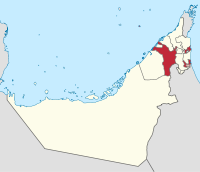|
1972 Sharjawi coup d'état attempt
In 1972, shortly after the formation of the United Arab Emirates, the former Sheikh of Sharjah, Saqr Al Qasimi, attempted to regain control over the emirate from his cousin Khalid bin Muhammad Al Qasimi. Although Saqr was able to secure the Emirate's palace, and kill Khalid, an intervention by the UAE's Trucial Oman Scouts besieged, and eventually forced Saqr's surrender. BackgroundSaqr bin Sultan Al Qasimi had been the Sheikh of Sharjah from 1951 to 1965, having succeeded his father, Sultan bin Saqr Al Qasimi II, and was deposed shortly after opening an office of the Arab League in Sharjah, and welcoming one of their delegations.[1][2][3] The British viewed Saqr and his support for Arab Nationalism as a threat to their interests in the Trucial States leading to British officials, led by Sir Terence Clark, to coordinate a coup in 1965 to crown Saqr's cousin Khalid bin Muhammad Al Qasimi.[3][4] Saqr would go into exile in Bahrain and eventually Cairo.[5] Sharjah would be the last Emirate to see a British presence during decolonization, with the British Royal Air Force base at Sharjah being the last physical presence of the British colonial government.[6] At the time of the coup, Khalid had become increasingly unpopular, especially among Sharjah's Arab nationalists, due to his handling, or lack thereof, of Iran's Seizure of Abu Musa and the Greater and Lesser Tunbs.[7][8] The Greater and Lesser Tunbs had been ruled by the Qasemi since before they migrated from the Persian coast to the present-day UAE in the 1720s.[7] Despite being highly unpopular by the UAE's Arab population, the British government pressured Khalid and the rest of the UAE's leadership to agree to Pahlavi Iran's demands and sign a memorandum of understanding that effectively surrendered the Islands to Iran.[8] CoupOn January 24, 1971, the Trucial States where officially decolonized and became the United Arab Emirates. Shortly after on December 2, 1971, Saqr smuggled himself into Sharjah with 7 Bedouin loyalists and a group of 18 Egyptian mercenaries, seeking to restore his throne.[8][6] Saqr would be supported by local Arab nationalists such as Sultan al-Oweis, however, due to the British withdrawal some months earlier, failed to rally the population to his anti-Colonial cause.[8] At approximately 2:30 PM Saqr and his forces took control of the Sheik's palace with reports of gunfire and grenade explosions.[9] During the fighting Khalid would be killed, either being captured and executed, or as a combatant alongside one of his bodyguards.[6]However, within an hour of taking the palace, Saqr would be besieged by the Trucial Oman Scouts who were based out of the former RAF Sharjah who were quickly joined by police from Dubai.[8][6] Early in the morning of January 25 Saqr surrendered himself and his forces to Mohammed bin Rashid Al Maktoum.[9] AftermathSaqr would be tried and imprisoned until 1979, after which he returned to exile in Egypt where he spent the rest of his life.[8] Khalid's younger brother Sultan would be named the new Sheikh of Sharjah, passing over the older `Abd al-`Aziz which would lead to `Abd al-`Aziz to attempt to stage his own coup in 1987 which was also unsuccessful due to Emirati intervention.[10] Mohamed bin Zayed Al Nahyan wrote in his autobiography that during the coup, the leading concern among Emirati leadership was that it would spiral into a regional conflict that would "involve foreign factions, supporters and followers" mostly due to Saqr's support for the ideals of Gamal Abdel Nasser.[6] References
|
||||||||||||||||||||||||||||||||||||
